The weather was splendid, 36°C without any wind while Emil Barnea and his girlfriend Miss Matea walked in the forest with a couple of friends. His friend shouted that she sees "something," and when he joined her he also saw a large round object, of metallic appearance and shining in the sun in the sky above the top of the trees. Amazed, Barnea remembered all the same that he had his camera and while the UFO advanced slowly changing direction and increasing its luminosity, then suddenly accelerating until it disappeared at the horizon. He had time to shoot four photographs.
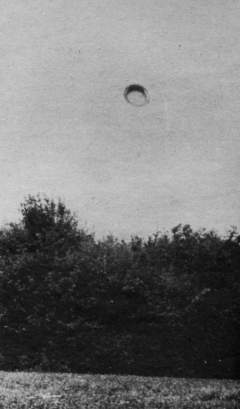
|
In the morning of August 18, 1968, Emil Barnea, a 45 year old construction technician, which had been an officer in the army, known for his integrity, and his girlfriend Zamfira Mattea, aged 34, employee in a charity organization, were taking a walk and went towards the wood of Hoia-Baciu, near the city of Cluj in Romania. They were accompanied by two other people, a man and a woman, who remained anonymous becasue they wanted their privacy respected.
The weather was splendid, and the four decided to stop and have lunch under the sun in a small clearing of the wood, close of the road from Cluj to Bucharest.
Emil Barnea went to seek seasoned wood for a campfire. There was no wind, and the only sounds were the birds singing.
He then heard his girlfriend calling to invite it to come see something which intrigued her. It was 01:23 p.m.
Barnea came back from the clearing and looked at what her girlfriend indicated to him: above the clearing where they were, there was a round craft in the sky, rather large, of metallic appearance, which reflected the sunlight as if it were silver plated. The machine slowly flew above the wood, without any noise.
Barnea then rushed towards his bag of which he extracted his camera, he estimated the lighting and the distance and took a first photography. As the machine went always rather slowly, it had more than enough time to take a second shot.
He noticed variations of luminosity of the craft, and its fluctuating flight.
At this time, the craft suddenly accelerated, going up, and Barnea had just the time to take two more photographs before the machine was too far away to be seen.
His fourth photograph was never publicly published because the other couple appeared on it, and they really did not want to be identified. This fourth photography was nevertheless shown by Emil Barnea to ufologists Florin Gheorghita and Ion Hobana later, it shows the machine who had become very small in relative size and as lost in a sort of cloud.
The four witnesses had followed all the evolutions of the machine, which had lasted approximately two minutes, and then stood quite some time in awe and not knowing what to say.
At the end of a few days, the shock which this experiment had caused them had dissipated. At the end of one week or two, the film roll in Emil Barnea's camera was finished, and he developed it and made some prints. he was hesitant as of what to do about the observation and of the photographs, knowing that people talking of flying saucers were generally ridiculed.
At the beginning of September of that year, Rumanian engineer Florin Gheorghita, of Cluj, who was used to investigating UFO reports in that area, returned from holidays. Barnea knew him because he had met him for business two years before while he worked in construction. Barnea knew that Gheorghita was interested in UFO matters, he had told him at the time that he was not really interested in flying saucers stories and had expressed his skepticism on this matter, skepticism which had no grounds anymore.
It thus told Gheorghita what had happened and showed him the photographs. Gheorghita made his investigation and reconstituted the sequence of events on the premises. He managed to check that the flightpath of the craft as indicated by Barnea and Mattea matched perfectly with the sequence of the visual observations and their spacing in time. According to the configuration of the premises, such as details of the vegetation, he managed to make calculations to estimate the altitudes and the approximate size of the object, which also corresponded very well to the visual estimates of the witnesses. He then wrote and published an investigation report on the case. He also sent the photographs to state news agency Ager Press.
One of the photographs was then published in several newspapers on September 18, 1968, accompanied by a summary of the events written by Barnea.
After having taken knowledge of the case through the newspapers, the director of the observatory of Cluj stated that the whole business must have been "either a mystification, or some weather balloons photographed in particular circumstances." He was not even aware that there was only one object photographed. He added that the witness was an ignorant illiterate, undoubtedly an alcoholic, and that his photographs were faked.
There was all the same a fast investigation to seek for possible blimps or weather balloons presence in that place and at that time, and none were found.
The negative were examined to see whether they were tampered with by a photographer reporter of Cluj, and then by a specialist in photography of the Ager Press agency in Bucharest. Both concluded that there were no trace of any trickery.
The film was again examined by a commercial photo laboratory which also considered it perfectly normal, without traces of falsification.
Thereafter, three of the photographs were published in the Press and long debates followed. Barnea and his girlfriend were interviewed lengthily by the state television, and Barnea was subjected to tests carried out by a journalist of Informatia Bucurestiului in order to show that he had very good means of sensory perception.
Technicians of the University of Cluj lengthily studied the photographs and built and photographed small-scale models of the craft to check if the shades were in agreement with the described manouvres, and as Barnea had indicated, they estimated that the machine, in addition to reflecting the sunlight, was to also have emitted its own light.
Rumanian ufologist and Well known author Ion Hobana started his own investigation, going ont he premises, meeting Mr. Barnea in 1968, then once again in 1970. He pointed out that neither Barnea nor hisr friend Miss Mattea knew much about flying saucers and UFOs, this was only normal since in Romania in 1968, books about UFOs weren't sold.
Hobana established the following:
Hobana also explained that in Romania at that time, there was no posibility of selling documents and that their publication implied by no means a benefit to their author, and that is it thus impossible to put forth the notion that the photographer hoxed images in the hope of a financial profit. He adds: "Moreover, you can easily guess that the citizens hardly took to risk to ridicule the authorities by proposing faked documents."
Other analyses and comments followed after the case was made known in the Western world via Hobana. He notes for example, about a study published in the french ufology magazine Lumières Dans la Nuit in 1971:
"The analysis by Belgian G. Delcorps is, in this respect, extremely interesting and instructive, not only by its conclusions, but also by the seriousness and the precision which characterize it. Unfortunately, Delcorps examined only the first two photographs. He noticed that on picture N.2 the UFO could not be at 85 degrees above the horizon, as stated by Barnea, but at about thirty degrees only. On the N.1 photograph, it is 20 degrees above the horizon and the calculable diameter is 22,3 meters, which was obtained by calculation and comparison with the trees and the solid masses. It left the assumption that the machine on photograph N.2 was within 600 m of the photographer. It is obviously possible since other calculations gave a value ranging between 360 and 480 m for the altitude."
"Delcorps too was struck by the abnormal distribution of the shades and the light, detail which jumps at even the least informed eyes. Without having been informed of the conclusions of his Rumanian colleagues, he came to the same results, namely firstly that the object on photograph N.2 is not the simple symmetrical image of that seen on photograph N.1, and secondly, that the machine had produced its own lighting. He estimates, moreover, that photographic faking is to be rejected completely."
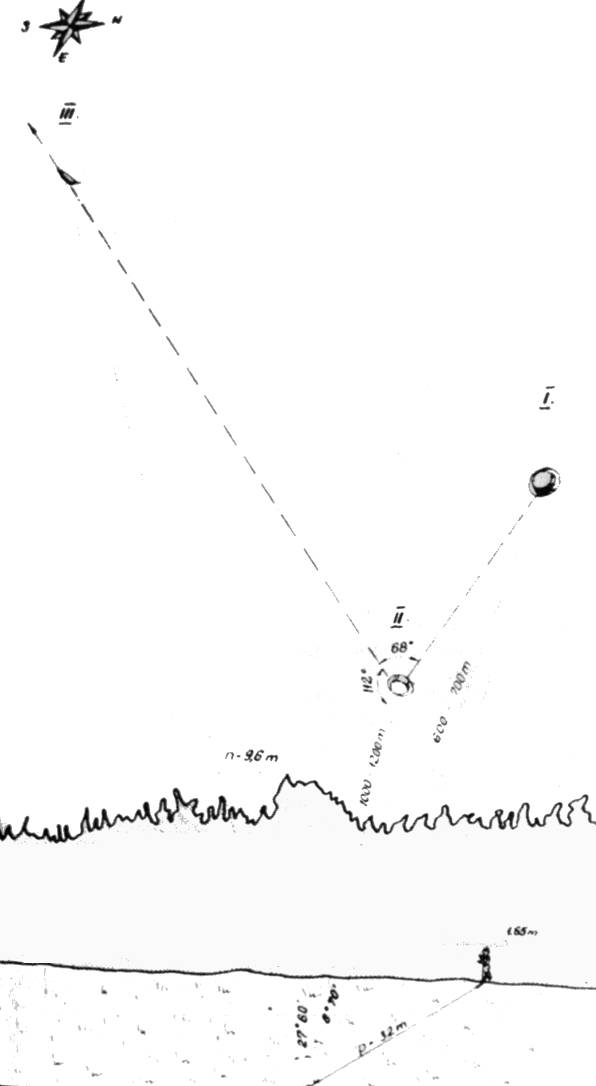
|
The drawing by investigator shows phase I, II, II of the sighting, to which the photographs by the witness correspond.
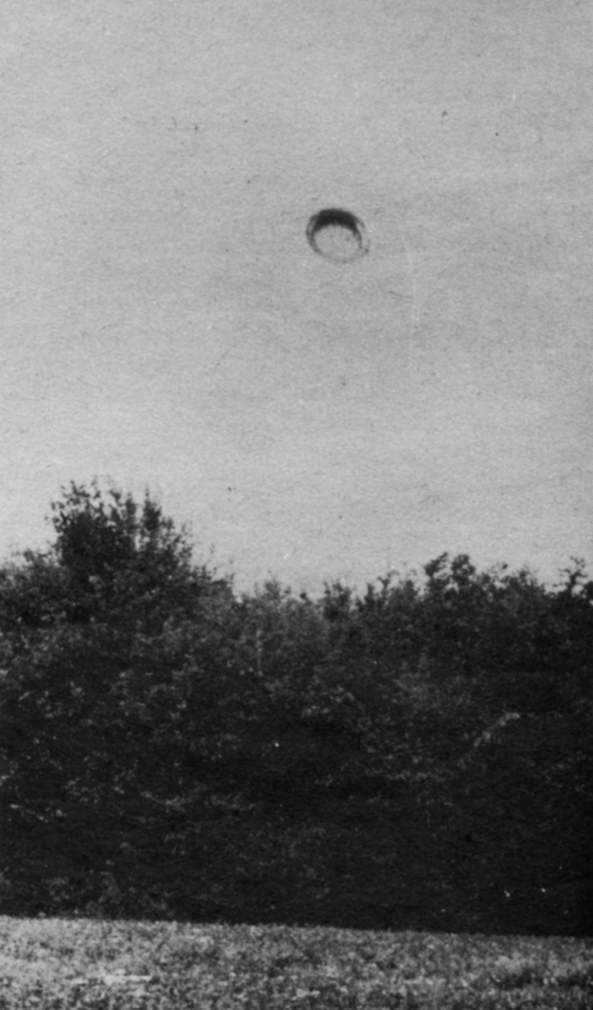
|
The second photograph. The UFO came from the upper left and reversed itself, it will now go to the upper left corner, as seen on the third photograph.
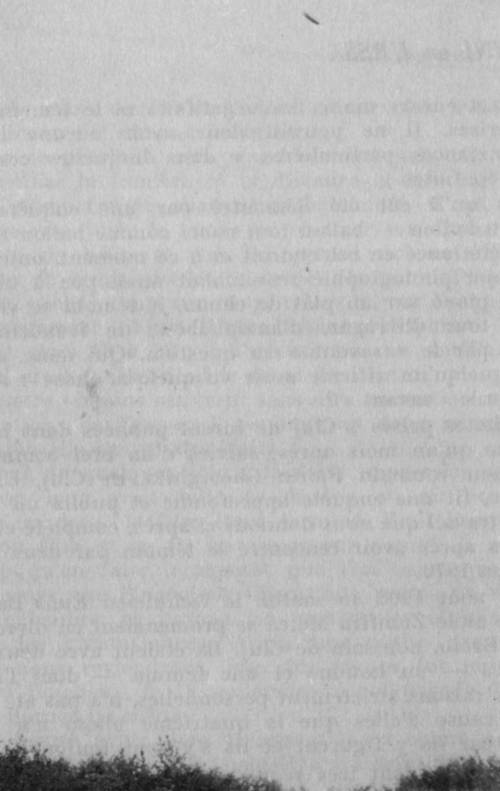
|
The third photograph. The UFO is now seen from the side and zooms away to the upper left.
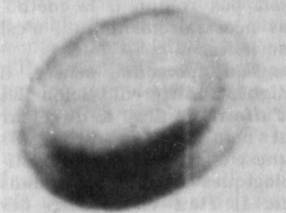
|
The object on the 1st photograph, enlarged.
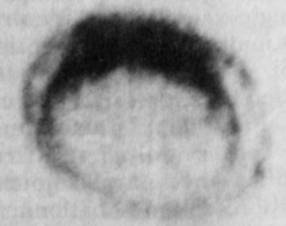
|
The object on the 2nd photograph, enlarged.
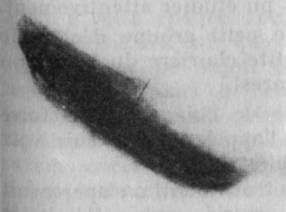
|
The object on the 3rd photograph, enlarged.
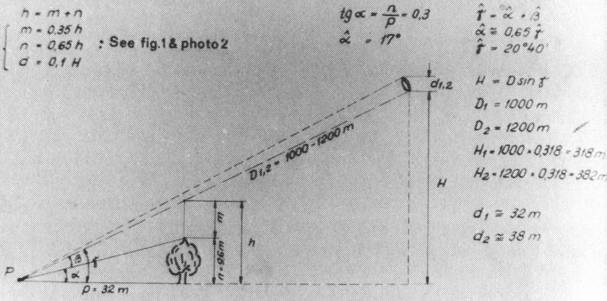
|
An estimate of the angular size of the object.